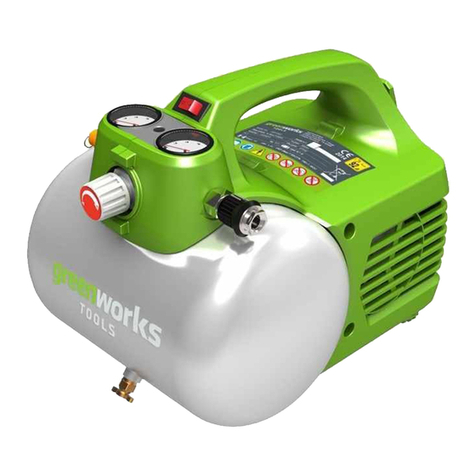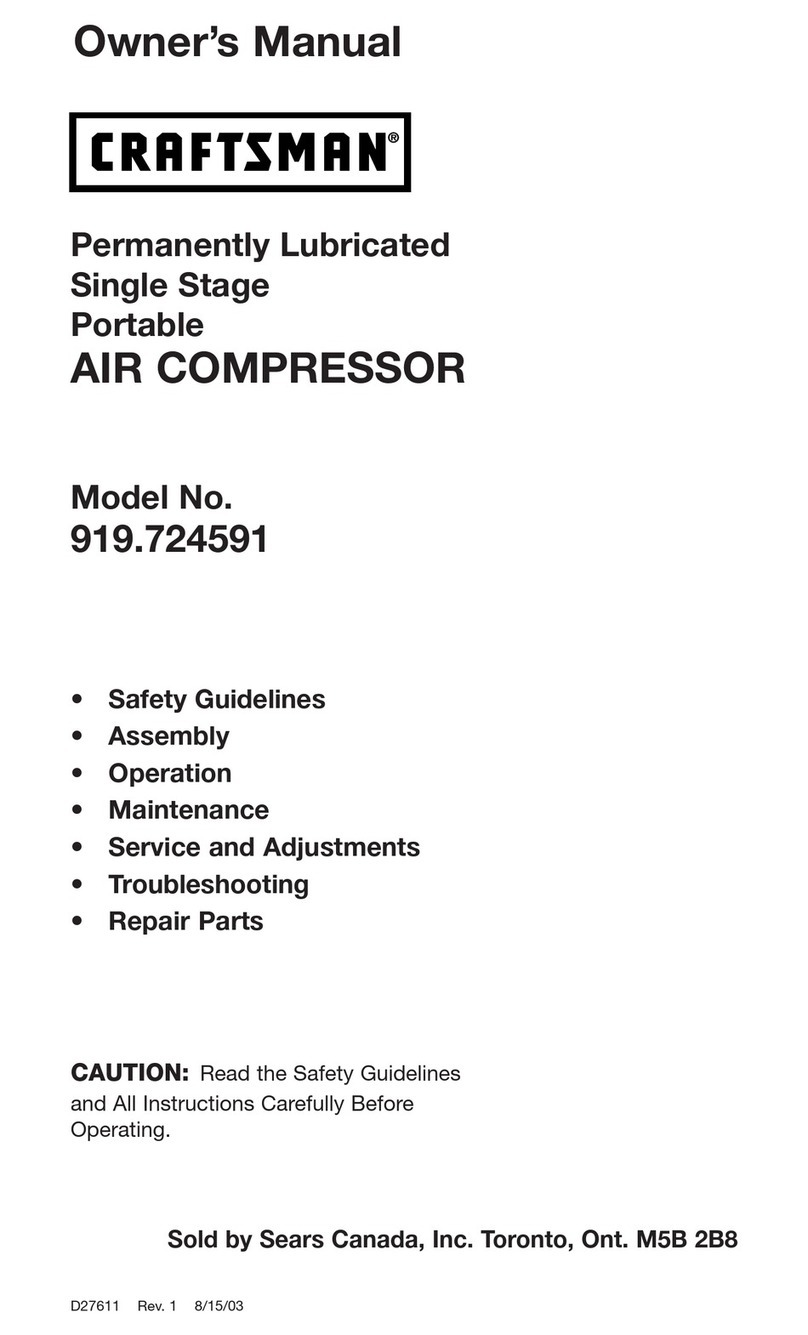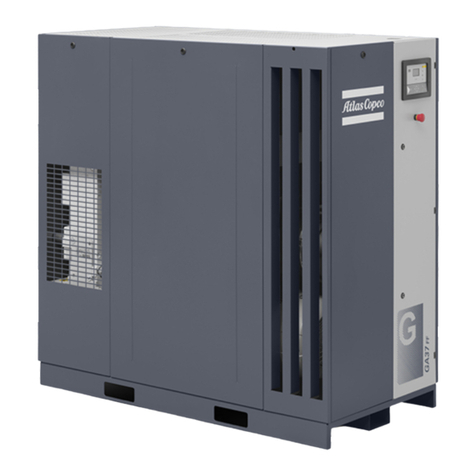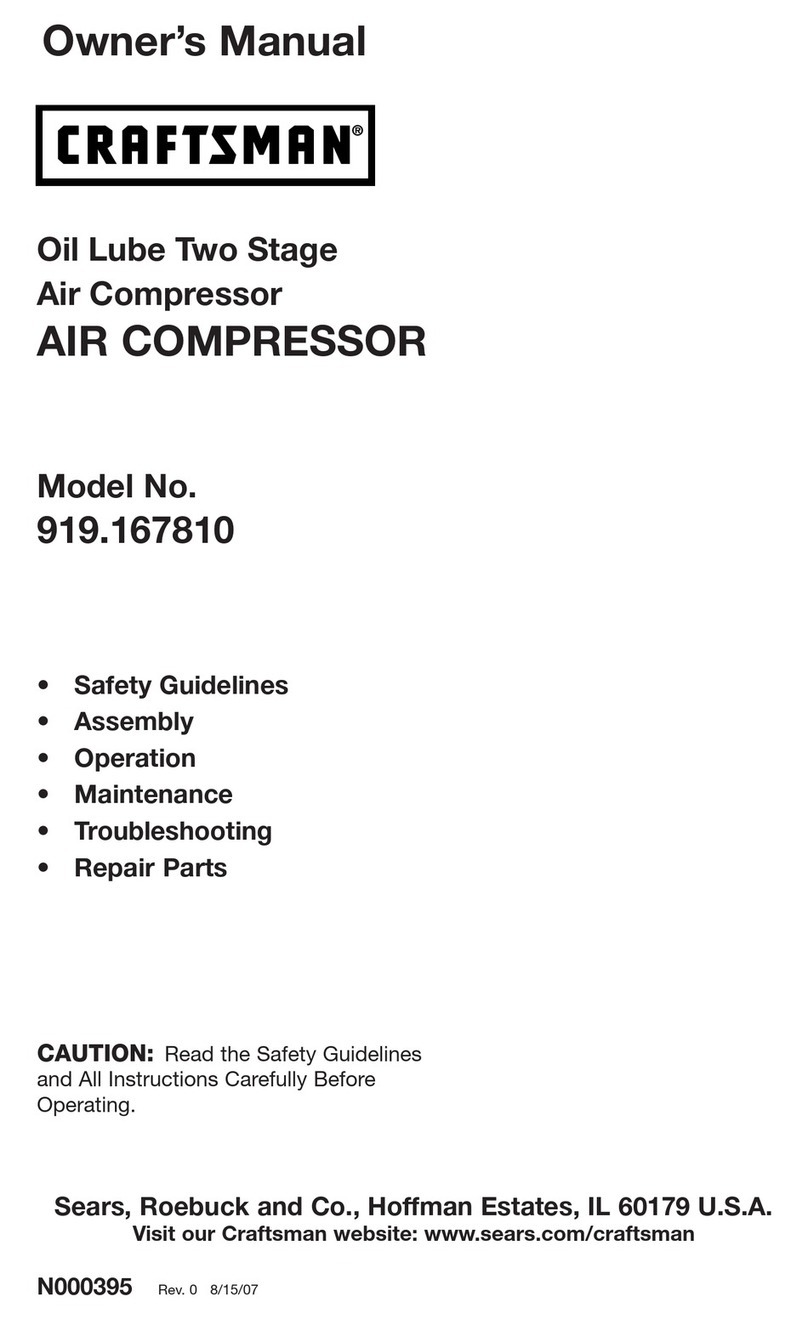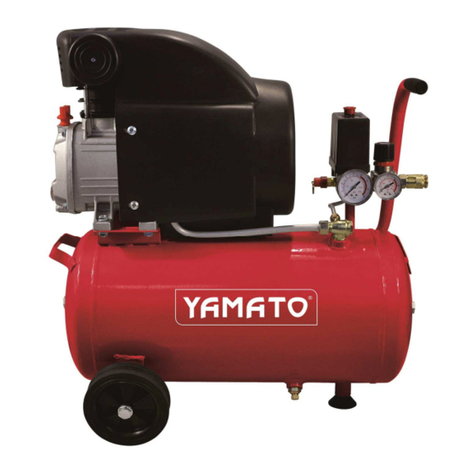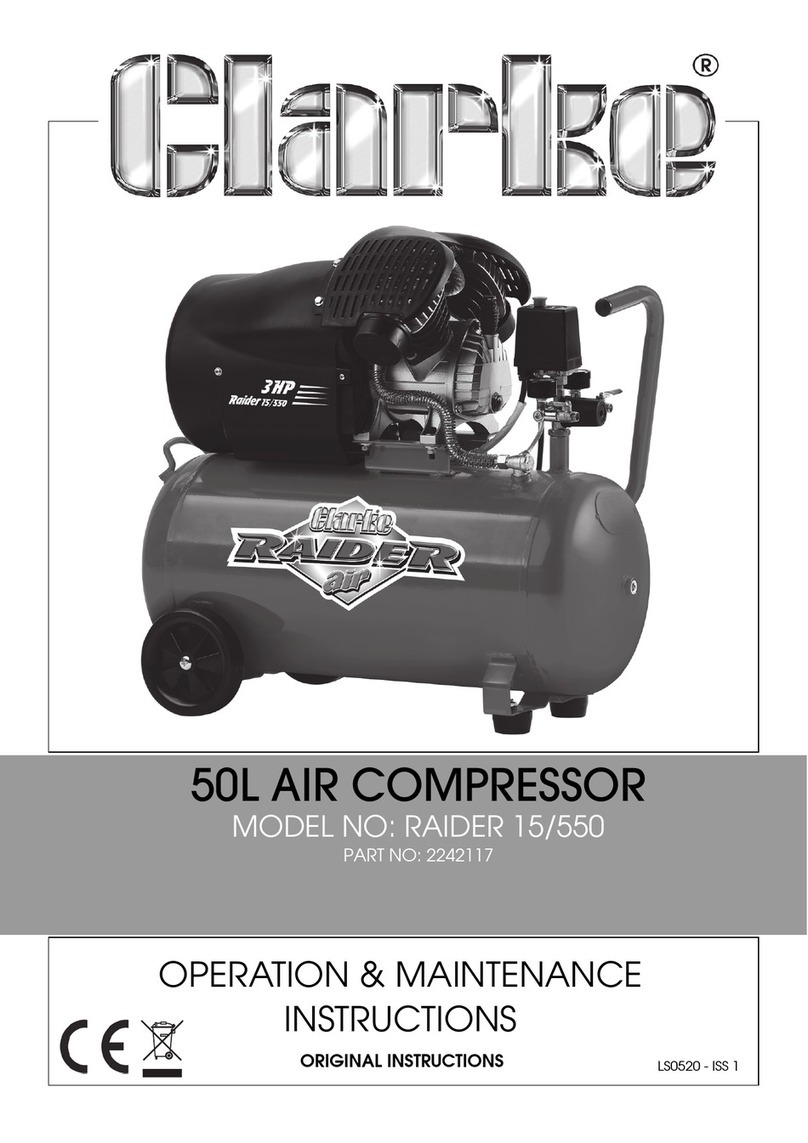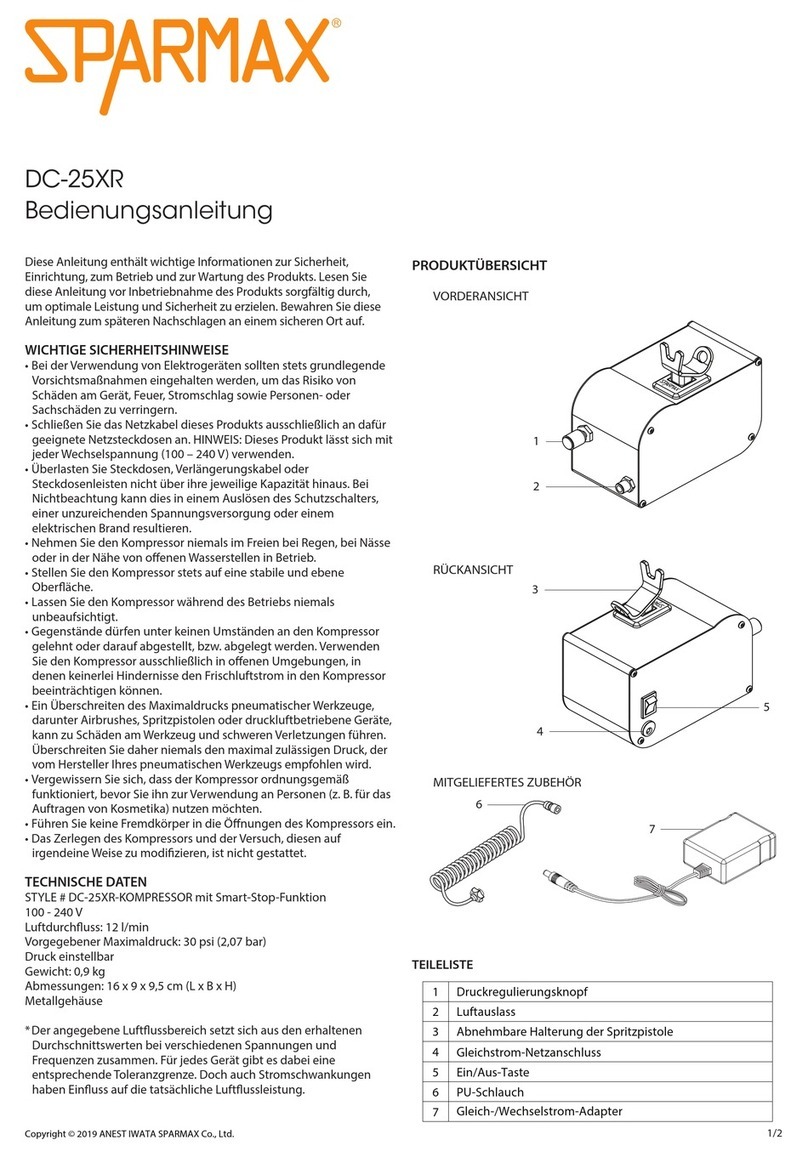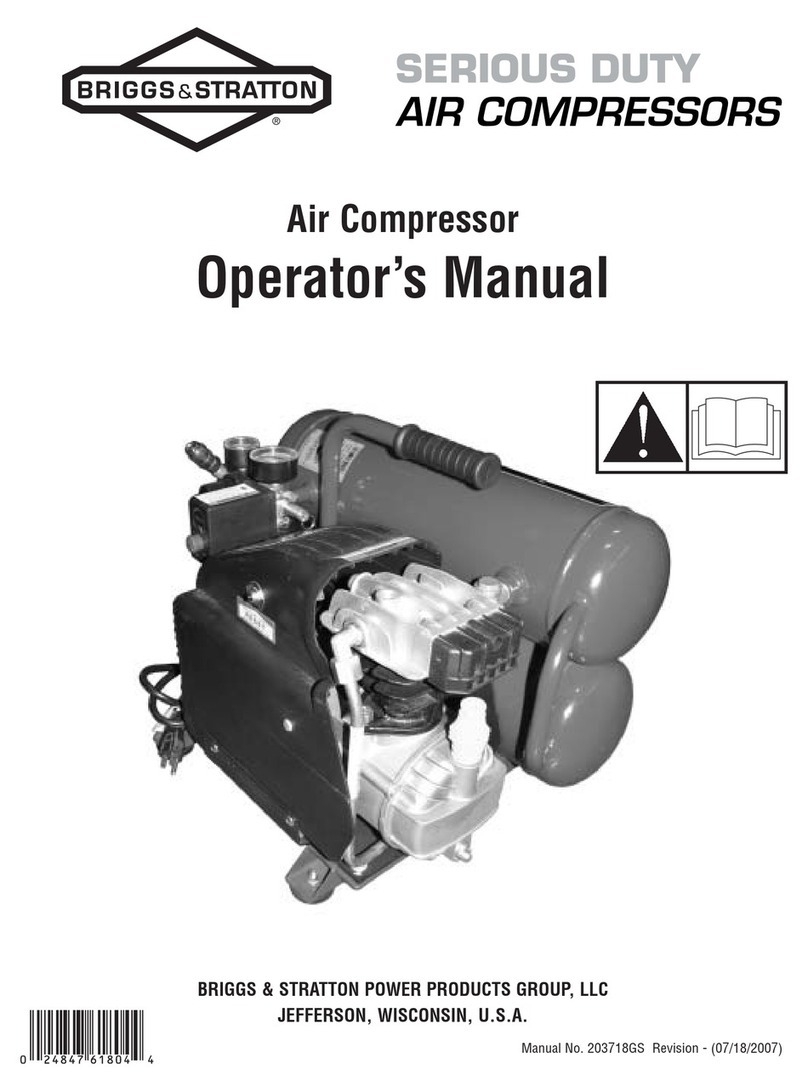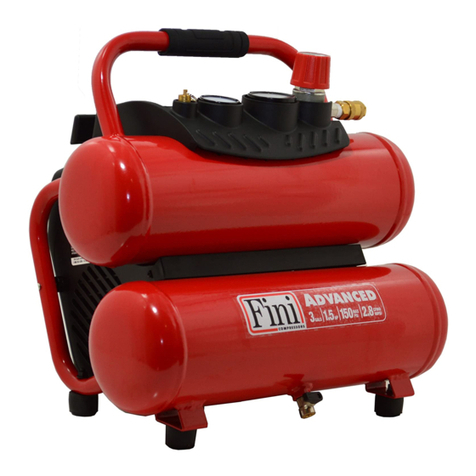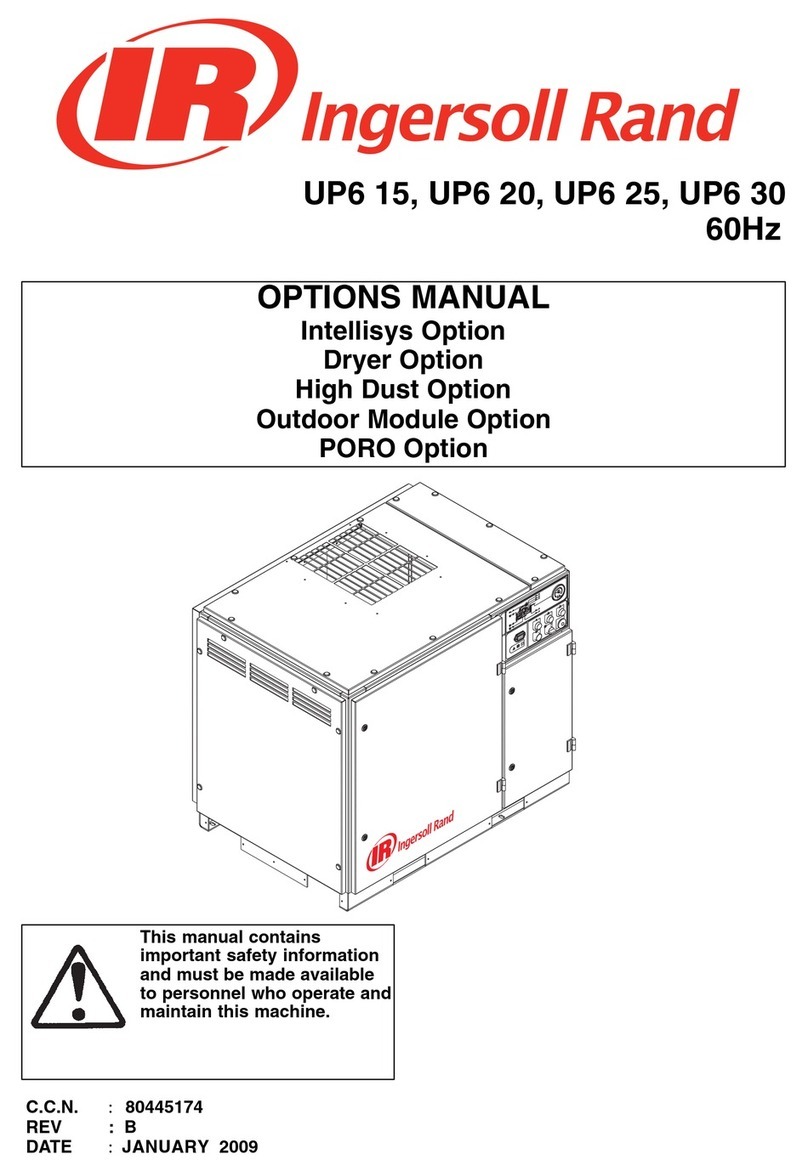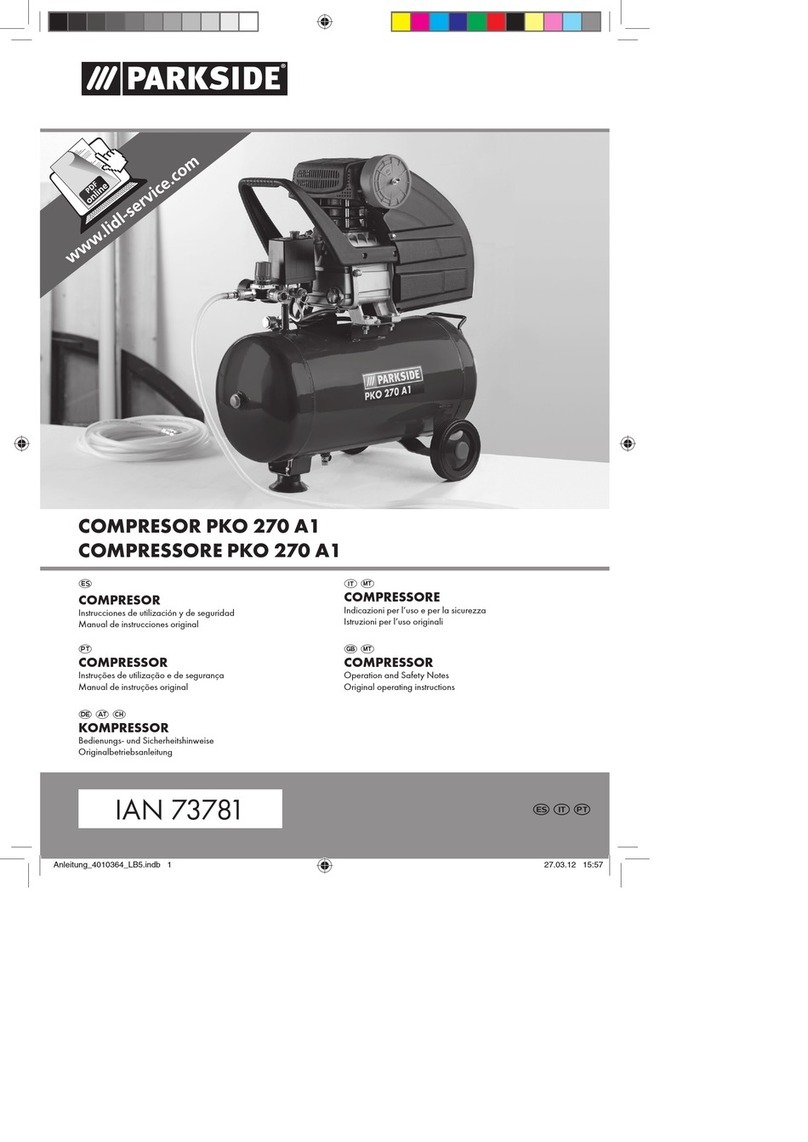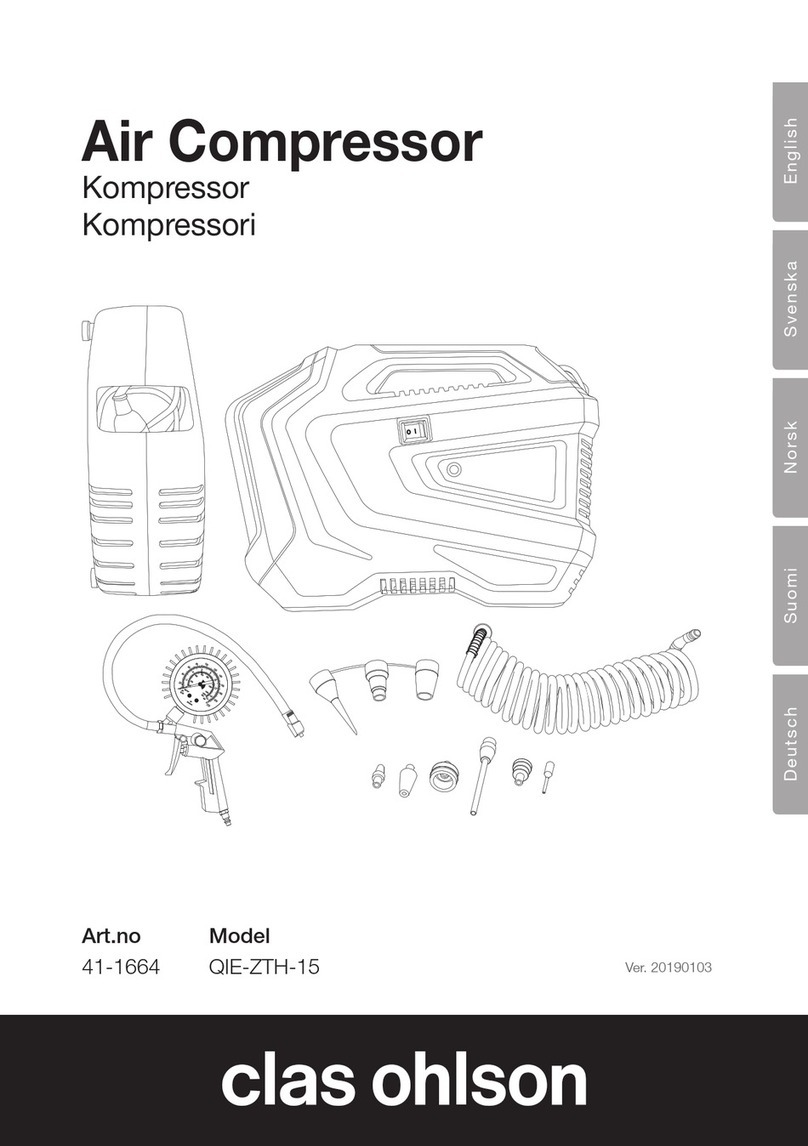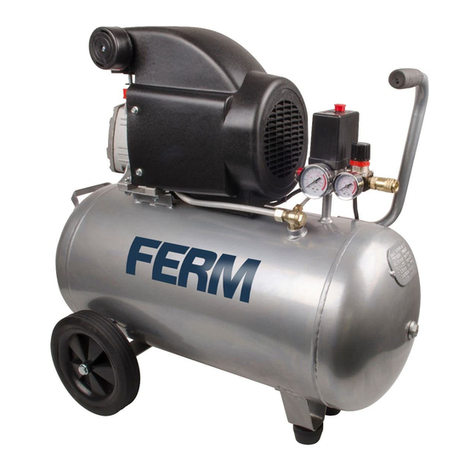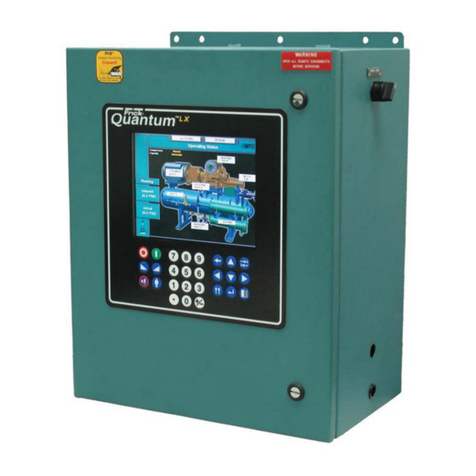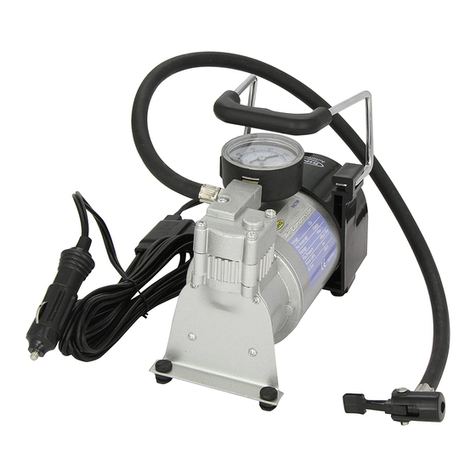GreenWorks Tools G40AC User manual

4100802/ 4100902/
4101002/ 4101102/
4101202
40 V AIR COMPRESSOR
COMPRESSEUR D’AIR DE 40 V
40 V LUFTKOMPRESSOR
COMPRESSORE ARIA 40 V
40 V LUCHTCOMPRESSOR
40 V KOMPRESSOR
COMPRESOR DE AIRE DE 40 V
COMPRESSOR DE AR DE 40 V
40 V KOMPRESSORI
40 V LUFTKOMPRESSOR
SPRĘŻARKA POWIETRZNA 40 V
ВОЗДУШНЫЙ КОМПРЕССОР 40 V
USER’S MANUAL
MANUEL D’UTILISATION
BEDIENUNGSANLEITUNG
MANUALE D’USO
GEBRUIKSHANDLEIDING
BRUGERVEJLEDNING
MANUAL DE UTILIZACIÓN
MANUAL DE UTILIZAÇÃO
KÄYTTÄJÄN KÄSIKIRJA
INSTRUKTIONSBOK
INSTRUKCJA OBSŁUGI
РУКОВОДСТВО ПО ЭКСПЛУАТАЦИИ
FR
GB
DE
ES
IT
NL
PT
DA
SV
FI
RU
PL

FIGURE SHEET
6
1
2
3
4
5
8
7
10
9
Fig. 1

English
3
c. Do not abuse cord. Never use the cord to carry
the tool or pull the plug from an outlet. Keep cord
away from heat, oil, sharp edges, or moving parts.
Replace damaged cords immediately. Damaged
cords increase the risk of electric shock.
d. When operating a power tool outside, use an
outdoor extension cord marked "W-A" or "W".
These cords are rated for outdoor use and reduce
the risk of electric shock.
3. PERSONAL SAFETY
a. Use safety equipment. Always wear eye
protection. Dust mask, nonskid safety shoes,
hard hat, or hearing protection must be used for
appropriate conditions.
b. Always wear eye protection with side shields,
along with hearing protection. Failure to do so
could result in objects being thrown into your eyes
and other possible serious injuries.
c. The employer and/or user must ensure that
proper eye protection is worn.
d. We recommend a wide vision safety mask
for use over eyeglasses or standard safety
glasses that provide protection against flying
particles both from the front and side.
e. Ensure compatibility of accessories before using.
f. Read and understand the operating manual for
any accessories or air tools before using.
g. Additional safety protection will be required in
some environments. For example, the working
area may include exposure to a noise level which
can lead to hearing damage. The employer and
user must ensure that any necessary hearing
protection is provided and used by the operator
and others in the work area. Some environments
will require the use of head protection equipment.
h. Stay alert, watch what you are doing, and use
common sense when operating a tool. Do not
use tool while tired or under the influence of drugs,
alcohol or medication. A moment of inattention
while operating power tools may result in serious
personal injury.
i. Dress properly. Do not wear loose clothing
or jewellery. Contain long hair. Keep your hair,
clothing, and gloves away from moving parts.
Loose clothes, jewellery, or long hair can be caught
in moving parts.
j. Do not overreach. Keep proper footing and
DESCRIPTION
1. OUTLET PRESSURE REGULATOR KNOB
2. SAFETY VALVE
3. AIR TANK PRESSURE GAUGE
4. TOOL OUTLET PRESSURE GAUGE
5. FEMALE QUICK CONNECT
6. AUTO ON/OFF SWITCH
7. 40 V LITHIUM-ION BATTERY (sold separately)
8. AIR TANK
9. AIR TANK DRAIN VALVE
10. CHARGER(sold separately)GENERAL SAFETY RULES
WARNING
Read and understand tool labels and manual. Failure to
follow could result in death or serious injury.
Save these instructions.
1. WORK AREA SAFETY
a. Keep your work area clean and well lit. Cluttered
areas and benches invite accidents. Floor must not
be slippery from wax or dust.
b. Do not operate power tools in explosive
atmospheres, such as in the presence of
ammable liquids, gases, or dust. Power tools
create sparks which may ignite the dust or fumes.
c. Keep bystanders, children, and visitors away
while operating tools.
d. Power tools create sparks which may ignite the
dust or fumes. Keep bystanders, children, and
visitors away while operating tools. Distractions
can cause you to lose control.
e. Operate air compressor in an open area at least 457
mm away from any wall or object that could
restrict the ow of fresh air to ventilation
openings.
2. ELECTRICAL SAFETY
a. Avoid body contact with grounded surfaces
such as pipes, radiators, ranges, and refrigerators.
There is an increased risk of electric shock if your body
is grounded.
b. Do not expose power tools to rain or wet
conditions. Water entering a power tool will
increase the risk of electric shock.

English
4
balance at all times. Proper footing and balance
enables better control of the tool in unexpected
situations.
k. Do not use on a ladder or unstable support.
Stable footing on a solid surface enables better
control of the tool in unexpected situations.
l. This appliance can be used by children aged from 8
years and above and persons with reduced physical,
sensory or mental capabilities or lack of experience
and knowledge if they have been given supervision
or instruction concerning use of the appliance in
a safe way and understand the hazards involved.
Children shall not play with the appliance. Cleaning
and user maintenance shall net be made by children
without supervision.
4. TOOL USE AND CARE
a. Do not exceed the pressure rating of any
component in the system.
b. Protect material lines and air lines from damage
or puncture. Keep hose and power cord away from
sharp objects, chemical spills, oil, solvents,
and wet oors.
c. Check hoses for weak or worn condition before
each use, making certain all connections are
secure. Do not use if defect is found.
d. Purchase a new hose or notify an authorized
service center for examination or repair.
e. Release all pressures within the system slowly.
Dust and debris may be harmful.
f. Store idle tools out of the reach of children and
other untrained persons. Tools are dangerous in
the hands of untrained users.
g. Maintain tools with care. Follow maintenance
instructions. Properly maintained tools are easier
to control.
h. Check for misalignment or binding of moving
parts, breakage of parts, and any other condition
that may affect the operation of the tool. If damaged,
have the tool serviced before using.
i. Many accidents are caused by poorly maintained tools.
j. Never point any tool toward yourself or others.
k. Keep the exterior of the air compressor dry, clean,
and free from oil and grease. Always use a
clean cloth when cleaning. Never use brake uids,
gasoline, petroleum-based products, or any strong
solvents to clean the unit. Following this rule will
reduce the risk of deterioration of the enclosure plastic.
5. SERVICE
a. Tool service must be performed only by qualied
repair personnel. Service or maintenance
performed by unqualied personnel may result in a
risk of injury.
b. Disconnect power supply, open drain valve to
decompress tank and allow water to drain, and
allow air compressor to become cool to the touch
before servicing. Turn pressure regulator knob
fully counterclockwise after shutting off compressor.
c. When servicing, use only identical replacement
parts. Follow instructions in the Maintenance section
of this manual. Use of unauthorized parts or failure to
follow Maintenance instructions may create a risk
of injury.
SPECIAL SAFETY RULES
1. Know your air compressor. Read operation manual
carefully. Learn its applications and limitations, as well
as the specic potential hazards related to this tool.
Following this rule will reduce the risk of electric shock,
re, or serious injury.
2. Drain tank of moisture after use each day. If unit will
not be used for a while, it is best to leave drain valve
open until such time as it is to be used. This will allow
moisture to completely drain out and help prevent
corrosion on the inside of tank.
3. Risk of re or explosion. Do not spray ammable
liquids in a conned area. Spray area must be well
ventilated. Do not smoke while spraying or spray
where spark or ame is present. Keep compressors
as far from the spraying area as possible, at least
4.6 m from the spraying area and all explosive vapors.
4. Risk of bursting. Do not adjust regulator to result
in output pressure greater than marked maximum
pressure of attachment and/or the item being inated.
Never use at pressure greater than 8 bar.
5. Use an air pressure gauge periodically while
inating an item to check the air pressure.
6. The machine shall be connected to a circuit
protection device (fuse or circuit breaker). The
protection device shall be set at 10 A current, and
the user shall do necessary test according to clause
18.2.2 of EN 60204-1:2006 to check if the protection
device is suitable for use.
7. To reduce the risk of electric shock, do not expose
the machine to rain (water) or dust; store it indoors.
8. Inspect tank yearly for rust, pin holes, or other
imperfections that could cause it to become
unsafe. Never weld or drill holes in the air tank.

English
5
9. Make sure the hose is free of obstructions or
snags. Entangled or snarled hoses can cause loss of
balance or footing and may become damaged.
10. Use the air compressor only for its intended use. Do not
alter or modify the unit from the original design or
function.
11. Always be aware that misuse and improper handling
of this tool can cause injury to yourself and others.
12. Never step or stand on the work seat. Following this
rule will reduce the risk of serious personal injury.
13. Never leave a tool unattended with the coil air hose
attached.
14. Do not operate this tool if it does not contain a
legible warning label.
15. Do not continue to use a tool or hose that leaks air
or does not function properly.
16. Always disconnect the air supply and power
supply before making adjustments, servicing a
tool, or when a tool is not in use.
17. Do not attempt to pull or carry the air compressor by
the hose.
18. Your tool may require more air consumption than
this air compressor is capable of providing.
19. Always follow all safety rules recommended by
the manufacturer of your air tool, in addition to all
safety rules for the air compressor. Following this rule will
reduce the risk of serious personal injury.
20. Never direct a jet of compressed air toward people
or animals. Take care not to blow dust and dirt towards
yourself or others. Following this rule will reduce the
risk of serious injury.
21. Do not use this air compressor to spray chemicals.
Your lungs can be damaged by inhaling toxic fumes.
A respirator may be necessary in dusty environments
or when spraying paint. Do not carry while painting.
22. Inspect tool cords and hoses periodically and,
if damaged, have repaired at your nearest
authorized service center. Constantly stay aware of
cord location. Following this rule will reduce the risk of
electric shock or re.
23. Check damaged parts. Before further use of the air
compressor or air tool, a guard or other part that is damaged
should be carefully checked to determine that it will
operate properly and perform its intended function.
24. Check for alignment of moving parts, binding of
moving parts, breakage of parts, mounting, and
any other conditions that may affect its operation.
A guard or other part that is damaged should be
properly repaired or replaced by an authorized service
center. Following this rule will reduce the risk of shock,
re, or serious injury.
25. This equipment incorporates parts, such as snap
switches, receptacles, and the like that tend to
produce arcs or sparks and, therefore, when
located in a garage, it should be in a room or
enclosure provided for the purpose, or should be
460 mm or more above the oor.
26. Never store tool with air connected. Storing the tool
with air connected can result in unexpected ring and
possible serious personal injury.
27. Protect your lungs. Wear a face or dust mask if the
operation is dusty. Following this rule will reduce the
risk of serious personal injury.
28. Do not operate coiled air hoses above the rated
pressure. Following this rule will reduce the risk of
serious personal injury.
29. If the power supply cord is damaged, it must
be replaced only by the manufacturer or by an
authorized service center to avoid risk.
30. Save these instructions. Refer to them frequently
and use them to instruct others who may use this
tool. If you loan someone this tool, loan them these
instructions also.
31. Operate the machine in front of the control panel.
32. When the machine is in operation, many parts
of machine may cause a high temperature. Use
necessary personal protection equipment such
as gloves to avoid injuries resulting from a high
temperature.
33. The power switch must be in off condition before
inserting the battery again.
This manual suits for next models
5
Table of contents
Languages:
Other GreenWorks Tools Air Compressor manuals
